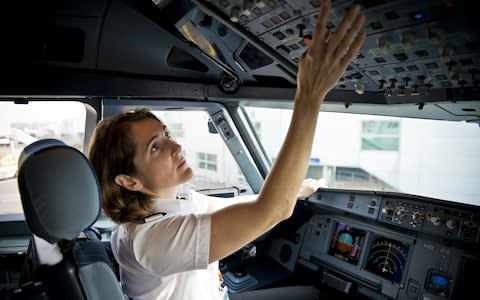The surprising country with more female pilots than any other
In 2012 India was declared the worst of the G20 nations in which to be a woman, with misogyny and gender inequality deeply entrenched in a conservative society.
The sub-continent is, however, streets ahead in terms of the number of female pilots employed by its airlines, boasting a higher percentage of women in the cockpit than anywhere in the world.
Globally, just over five per cent of pilots are female, according to the Air Line Pilots Association International, whereas in India the figure is closer 13, more than twice as high as the proportion in a number of western countries, including the UK (the Civil Aviation Authority puts the number at 4.77 per cent) and US (the FAA says 4.36 per cent).
“It was difficult,” said Shweta Singh, a senior trainer at Jet Airways, of her road to becoming a pilot 20 years ago. “It was a male-dominated area and not easy to break into.”
Today, she told Reuters, it is much easier, with the country home to a booming aviation sector full of airlines taking part in recruitment drives. More and more Indian women want to become pilots, with a life in the sky as appealing as the benefits it offers, including union-mandated equal pay, a safe workplace and day-care services.
In a bid to encourage more female flight crew, airlines have also tackled the issue of safety on their commute, with employees offered pick-up and drop-off services, accompanied by an armed guard.
“It is the safest job,” said Singh. “Women are more protected here than in any other place.”
Airlines in the UK such as easyJet and British Airways have invested heavily in trying to attract - and hire - more female pilots, attempting to rid the role of the gender stereotypes inherited from the Second World War.
“I’ve been asked where the captain is,” easyJet pilot Marnie Munns recently told Telegraph Travel. “You’re looking at her, I say.”

The 41-year-old, who is helping to lead a charge by the budget airline to encourage more girls and women to become pilots, added: “Outside the cockpit is when you feel it more. Passengers do make comments. It’s normally extremely positive, but you do get the occasional ‘well done for landing, it was actually really smooth’, delivered with surprise.”
Munns believes the perception of pilot being a male occupation was preventing more women from entering the profession. “Society has conditioned us into thinking that only men will be interested, but it’s nothing to do with gender,” she said.
In India, however, the fastest growing aviation market in the world (domestic capacity grew 22 per cent in the first half of this year), the country’s airlines are succeeding in addressing its demand for pilots by hiring more women.
SpiceJet, a low-cost domestic airline, says 12 per cent of its pilots are women, but a target has been set to increase the ratio to 33 per cent in three years.
At the Bombay Flying Club, which has courses for commercial pilots, the number of women in the classroom has grown to about 25 percent from less than 10 percent five years ago, according to the institute’s principal and chief instructor, C. Kumar.
“The society is changing and there is more acceptance about working in the aviation sector,” Kumar told Reuters.
Because pilot pay is based on seniority and flying hours under union agreements, it is one of the rare professions in India where there is no gender pay gap.
The starting salary, including flying allowance, for pilots there is $25,000 to $47,000 a year depending on the airline and type of aircraft. That is similar to the starting salary for corporate lawyers or architects.
About 13 percent of the pilots at IndiGo, among the fastest growing airlines in the world, are women, up from 10 percent five years ago, the company said.
The company provides day care and says it offers pregnant women office duties and an allowance equivalent to what they would have earned flying, helping them “constructively stay engaged with the profession.”
Earlier this year, the publication of the gender pay gap in the UK highlighted the gulf in equality at British airlines, with all above the country average median pay difference of 9.7 per cent. Ryanair’s figure was 72 per cent, easyJet’s 45.5 per cent and BA’s 10 per cent.

